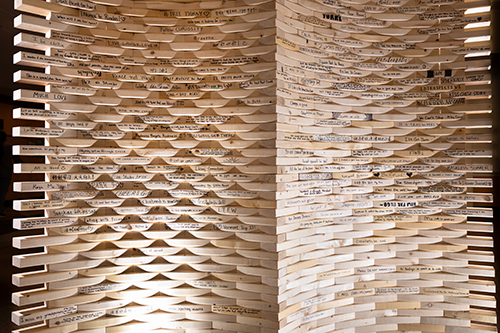No Mud, No Lotus.
That was one of many sayings inked on some 400 blocks of wood, each cut to resemble a brick that, stacked high, formed an art installation-in- progress at Valentine Dining Hall.
The resulting sculpture is called The Book of Hope. It took shape March 21–25, as artist Foon Sham and his assistants buttonholed students after they’d swiped their IDs in Val. He encouraged each of them to take a black marker and a blank block and inscribe the edges with a message.
The idea was to reflect on the difficulty and loss of the past two years—and the potential for hope and healing.
Some messages were COVID-specific, with varying degrees of crankiness: Get These Swabs Out of My Nose!, for instance, and I never want to eat in a tent again.


Some of the messages from the exhibit.
Others lifted spirits: Know Your Self-Worth! and What’s the best that can happen?
Sham, a sculptor and professor at the University of Maryland, College Park, was invited to Amherst by President Biddy Martin, an admirer of his work. His sculptures have gone up at many sites in the Washington, D.C., area, including, currently, the Smithsonian Gardens. His signature material is wood.
Inside Val, he perused the messages on the blocks and was struck by the Babel of languages on display. For example: Kaya Mo Yan! (“You Can Do It!” in Filipino) and Solo l’amore può aiutare guarire l’odio nel mondo (“Only love can help heal hatred in the world,” in Italian).
“To me,” Sham said of the project, “it’s an artwork to share thoughts and feelings, but at the same time, it’s a place where we get all the thoughts together in one ‘book.’ To take that one step further: By being interactive in front of it, you are allowed to also leave something behind. And then hopefully there’s healing. Then peace.”
The Book of Hope featured several quotes from thinkers and writers. The No Mud, No Lotus saying is the title of a book by the late Vietnamese monk and peace activist Thich Nhat Hanh. There were also lines from F. Scott Fitzgerald, Viktor Frankl and Miguel de Cervantes. Christian Pattavina ’24 contributed a verse from “This Hour and What Is Dead,” by the Indonesian poet Li-Young Lee: Someone tell the Lord to leave me alone. / I’ve had enough of his love / that feels like burning and flight and running away.
“The poem is very powerful in its own right,” Pattavina said in Val, “and it’s super relative to the idea of the sculpture, how we’ve suffered in such a complicated and nuanced way, in a cloud full of feelings.”
As the smell of sawdust mingled with fragrances of sautéed shrimp, pizza and coffee, other students approached the sculpture, and you could hear them laugh at contributions such as Batman Struggles Too and Live, Laugh, Love. Someone else offered this written plea: Let Me Off the Wait-List!!!
In the third year of the pandemic, that was something everyone could agree on.
Photographs by Maria Stenzel
